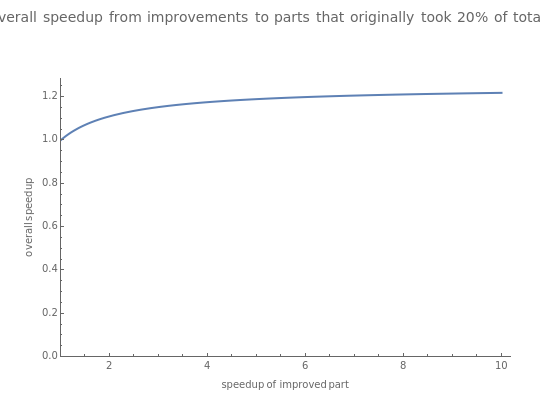Amdahl's Law
Amdahl's Law
Amdahl' s Law summarizes the performance improvement of some process, such as a computer program. It considers that in order to improve performance (time to complete the process), only a part of the entire process is usually improved. It shows that the improvement is limited by the fraction of time the improved part is used. It can be stated in terms of two parameters: , the fraction of time spent in the improved part, and the speedup , how many times faster the improved part performs. Amdahl's Law gives how many times faster the entire process will be as =.
f
S
S
overall
1
(1-f)+
f
s
Details
Details
Amdahl's Law gives the insight to both hardware and software system designers that speed improvements to just one part of a system have a limit to the overall benefit, and improvements should be balanced across all parts of the system. For example, there is a limit to improving the response time of a web server by increasing the CPU clock speed. At higher clock speeds the overall fraction of time spent in the CPU becomes vanishingly small compared to other unimproved parts of the system. Using absolute execution times, Amdahl's law is in terms of , the execution time after an improvement; , the execution time affected by the improvement; , how many times faster the improved part runs, or its speedup; and , the execution time unaffected by the improvement. In these terms, Amdahl's Law states that
T
after
T
improved
S
T
unaffected
T
after
T
improved
S
T
unaffected
However, more insight can be gained from the relative form shown below.
S
overall
1
(1-f)+
f
S
In this form it is easier to see what happens to the limit as increases, where reaches a maximum of .
S
S
overall
1
1-f
Permanent Citation
Permanent Citation
Joel F. Klein
"Amdahl's Law"
http://demonstrations.wolfram.com/AmdahlsLaw/
Wolfram Demonstrations Project
Published: September 28, 2007
